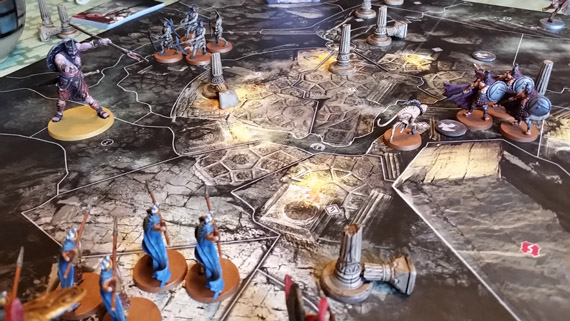The big surprise this year is how few games from last year's top 10 made the list, the biggest shocker being not only that X-Wing did not make it into the top 10, but we didn't play a single game of it in 2018. I chalk this up to us spending a lot more time playing other miniatures games, and also a lack of interest in the recently released X-Wing Second Edition.
11 (tie). Covert
5 plays, 12.5 hours (average play time 2.5 hours per game)
A lavish game that's relatively simple yet very engaging. I love the cold war spy genre, and Covert evokes that nicely with it's European setting and cards representing spy gadgets like miniature cameras and briefcase tape recorders.
Read the full review.
5 plays, 12.5 hours (average play time 2.5 hours per game)
2018 was the year we finally got some decent Doctor Who tabletop games. This one manages to capture the feel of Doctor Who quite well but it does seem a little incomplete, an issue that will hopefully be remedied by the long-delayed expansions that will hopefully see the light of day soon.
Read the full review.
9 (tie). Lord of the Rings Trading Card Game
5 plays, 12.5 hours (average play time 2.5 hours per game)
At the behest of a friend who wanted to try it, we got this old gem out and actually spent a fair amount of time playing it this year. I still maintain that it is one of the most well-designed trading card games ever published.
Read the full review.
8. 7TV
5 plays, 13.5 hours (average play time 2.75 hours per game)
We've built up a fairly large collection of miniatures and terrain for this great skirmish game based on British "spy-fi" television of the 1970s such as The Avengers, The Prisoner and Life on Mars. The rules do a good job of providing a framework that allows us to immerse ourselves in the setting, which to me is the whole reason to play games like this.
Read the full review.
7. Yamataï
5 plays, 14 hours (average play time 2.75 hours per game)
I'd be rich if I could bottle and sell whatever it is that makes Jérémie Fleury's artwork so appealing. Thankfully, with Yamataï it's backed up by a very interesting exploration and resource management game.
Read the full review.
6 (tie). Clank! In! Space!
6 plays, 14 hours (average play time 2.5 hours per game)
I'm a big fan of deck-building games, but the can tend to get a bit repetitive. This one innovates by adding a board with a movement mechanic, as players attempt to rob an evil despot's space ship before anyone notices.
Read the full review.
5 (tie). Cthulhu Wars
6 plays, 14 hours (average play time 2.5 hours per game)
Cthulhu Wars is one of only two returning games from last year's top 10 list. Apart from the exceptional miniatures, it really is a compelling Risk-style strategy game.
Read the full review.
4. Doctor Who: Exterminate!
6 plays, 16.75 hours (average play time 2.75 hours per game)
We were a little lukewarm on this skirmish game when we originally picked it up in 2017, but the growing range of miniatures has rekindled our interest, especially since we can use the same tabletop terrain we've been assembling for 7TV.
Read the full review.
9 plays, 23 hours (average play time 2.5 hours per game)
This was one of my most anticipated games for this year, and I wasn't disappointed. It's a great engine-building game, and the recent expansion makes the game more interesting without making it more complicated.
Read the full review.
2. Conan
19 plays, 27.5 hours (average play time 1.5 hours per game)
The only other returning game from last year's top 10, Conan dropped one spot but still saw plenty of play in 2018. Part of this was due to an 8-week campaign that I talked one of my roleplaying groups into, but the ability to play this game as an ongoing series is part of what makes it such a great game.
Read the full review.
1. Mythic Battles: Pantheon
21 plays, 37.5 hours (average play time 1.75 hours per game)
Apart from the great miniatures, gorgeous artwork, and well-designed rules, the nicest thing I can say about this game is that every time we finish a game we want to play again.
Read the full review.
Honorable Mention
Western Legends
5 plays, 11.5 hours (average play time 2.25 hours per game)
A great open world adventure game set in the wild west. The fact that we played this game four times in the first month we got it tells me that it probably would have placed in the top 10 if we'd had it earlier in the year.
Read the full review.
Most anticipated game of 2019
Core Space
This game looks simply amazing. A board game/skirmish hybrid similar to Mythic Battles: Pantheon or Conan, with an intriguing semi-cooperative element that puts players in competition with each other for resources, but both at threat from an invading horde of killer robots. And rather than just a flat, printed board, it comes with Battle Systems 3D terrain.



















